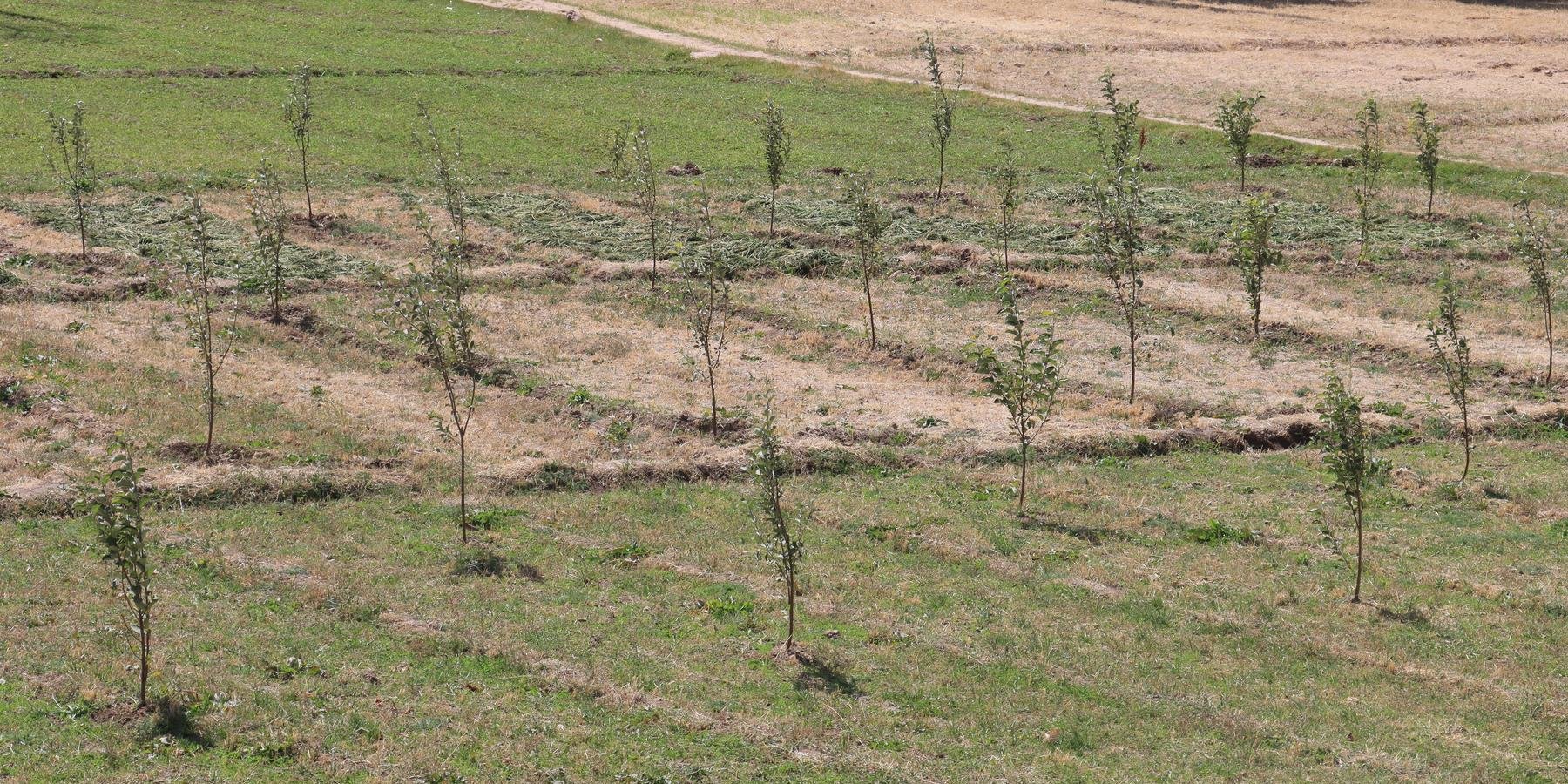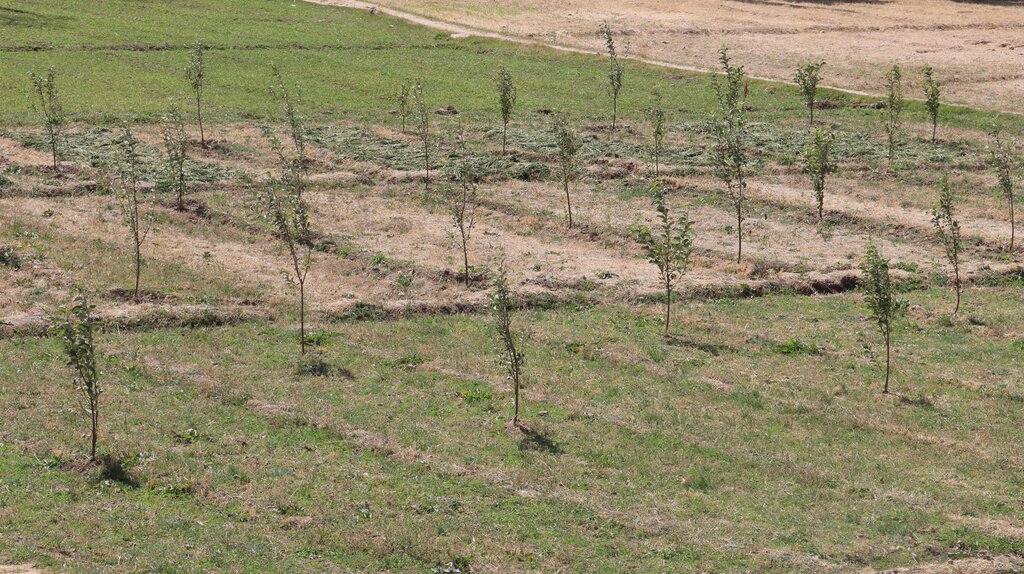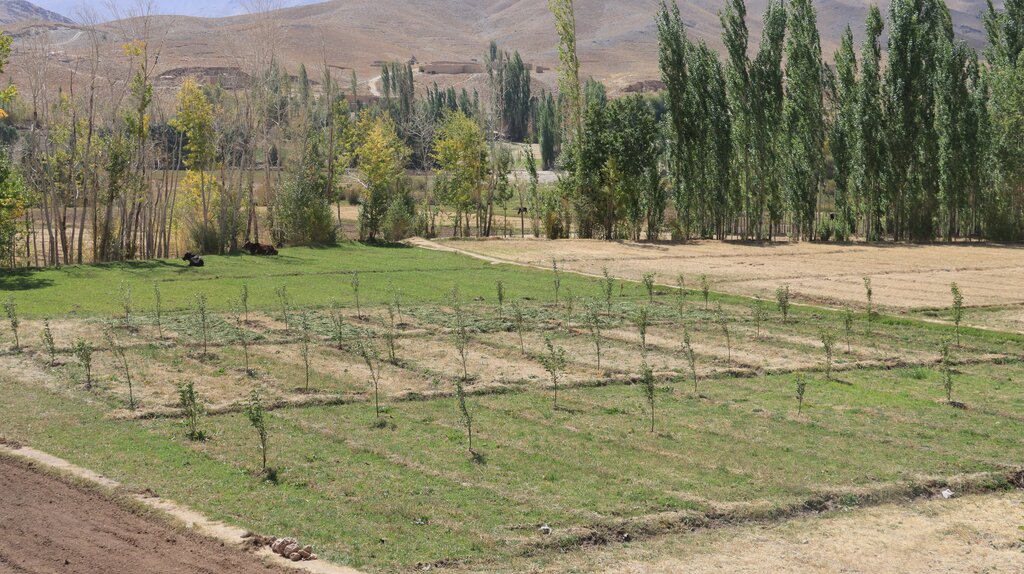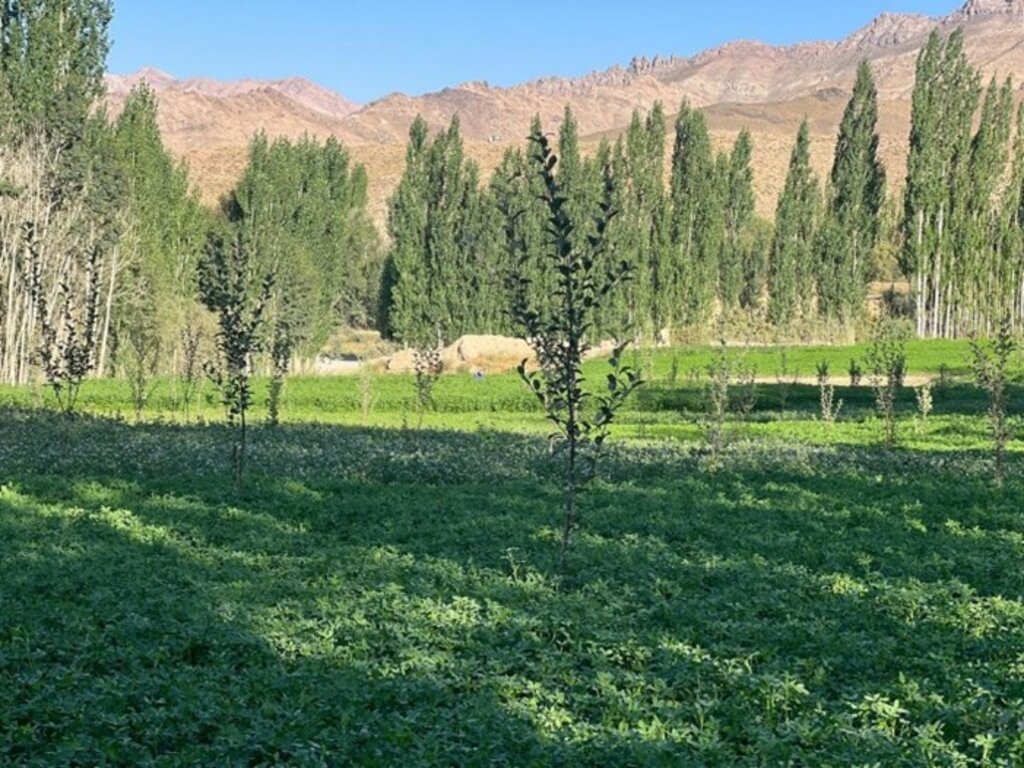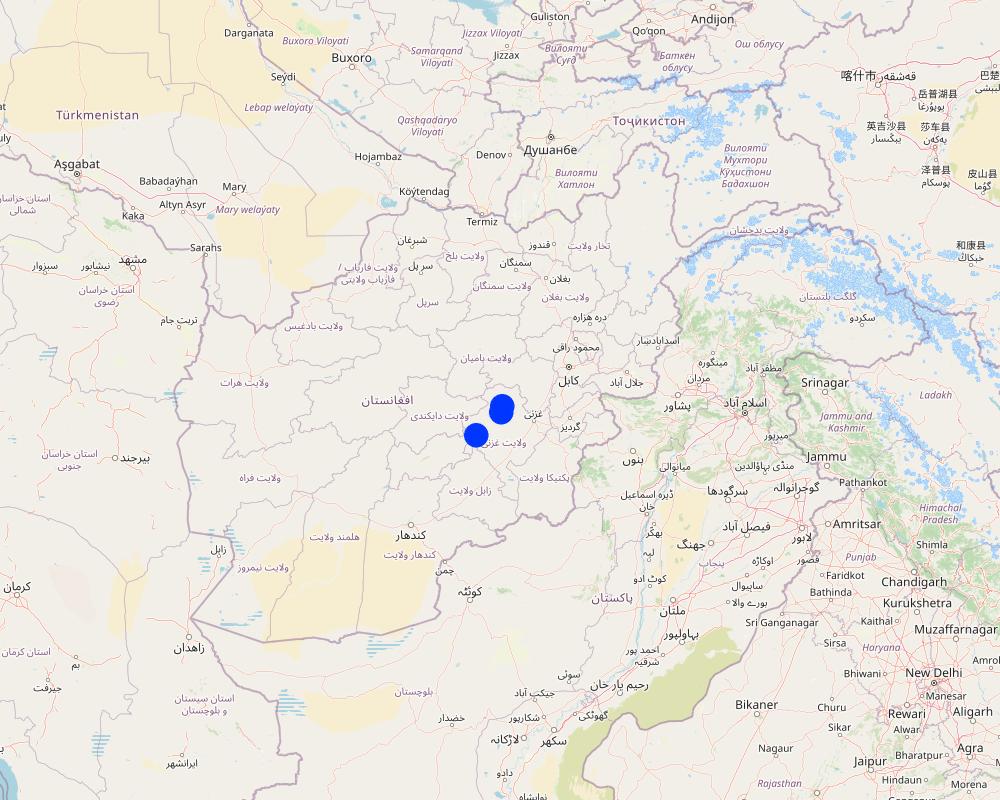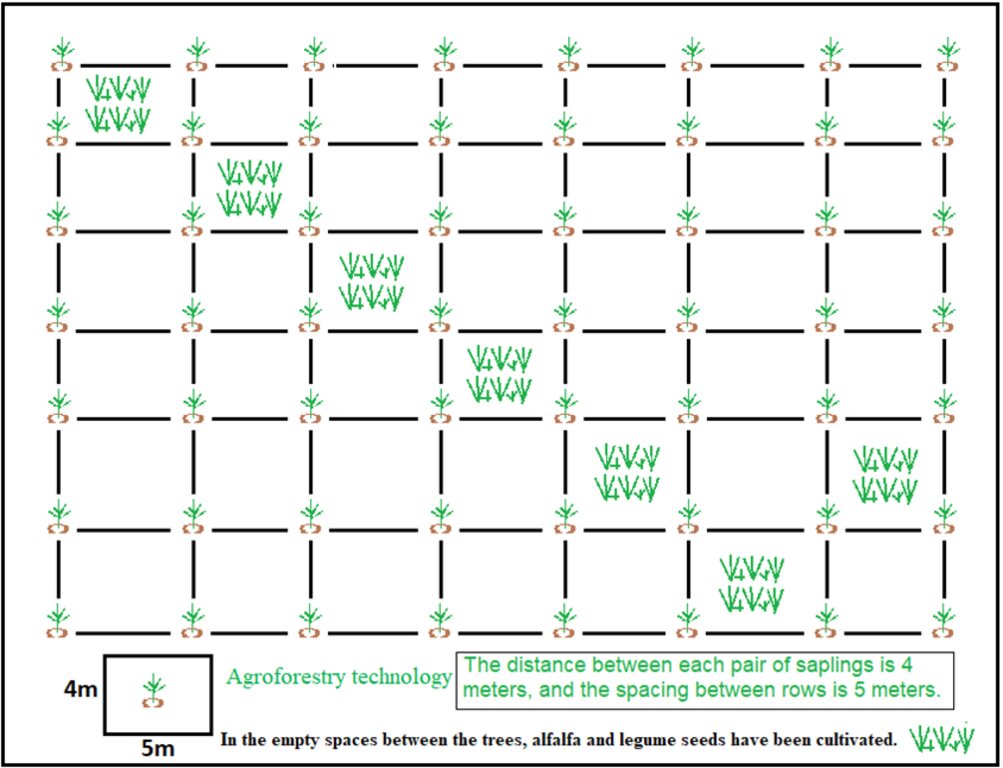Agroforestry to improve soil fertility, water retention, and sustainable income for local communities [阿富汗]
- 创建:
- 更新:
- 编制者: Ahmad Zia Jalalzai
- 编辑者: Mohammad Amin Nesar, Megha bajaj, Mir Wali Khan Lakanwal
- 审查者: Rima Mekdaschi Studer, Illias Animon, Muhammad Ishaq Safi
د خاورې د خاصلخيزۍ ودې، اوبو ذخيره کولو او محلي ټولنو له پاره د دوامداره عايد په موخه د کرنيزې ځنګلدارۍ قطعو جوړول /ایجاد پلات زراعت جنگلی برای بهبود سلامت خاک، نگهداری آب و تأمین درآمد پایدار برای جوامع محلی
technologies_7443 - 阿富汗
查看章节
全部展开 全部收起1. 一般信息
1.2 参与该技术评估和文件编制的资源人员和机构的联系方式
SLM专业人员:
SLM专业人员:
Andar Ahmadullah
FAO Afghanistan
阿富汗
土地使用者:
Mohammad Haider
Ghaibi Rangeland Management Association (RMA)
阿富汗
土地使用者:
Ghullam Sakhi
Qarcha Rangeland Management Association (RMA)
阿富汗
有助于对技术进行记录/评估的项目名称(如相关)
Community-based sustainable land and forest management in Afghanistan有助于对技术进行记录/评估的机构名称(如相关)
FAO Afghanistan (FAO Afghanistan) - 阿富汗1.3 关于使用通过WOCAT记录的数据的条件
编制者和关键资源人员接受有关使用通过WOCAT记录数据的条件。:
是
1.4 所述技术的可持续性声明
这里所描述的技术在土地退化方面是否存在问题,导致无法被认为是一种可持续的土地管理技术?:
否
注释:
This technology is applied with a focus on land restoration and conservation and is not problamatic with regard to land degradation.
2. SLM技术的说明
2.1 技术简介
技术定义:
The Agroforestry system in Malistan district combines traditional practices with support from the Community-Based Sustainable Land and Forest Management project in Afghanistan. This initiative provides technical support, training, and resources like apple trees, fertilizers, and alfalfa seeds to establish 400 orchards (1,000 m² each). The goal is to enhance community livelihoods by reducing dependence on rangelands, helping to preserve local ecosystems.
2.2 技术的详细说明
说明:
The agroforestry system adopted in the mountainous districts of Ghazni province, particularly in Navor and Malistan district is an innovative approach that is transforming the way local farmers cultivate their land. This system integrates agricultural crops, tree cultivation, and livestock farming to maximize land productivity while promoting environmental sustainability. At the heart of the system are apple orchards, alfalfa seeds, and fertilizers, which work together to enhance food security, provide livestock feed, and improve soil fertility. Supported by modern agricultural techniques, the project includes a total of 400 orchards, each covering 1,000 square meters, helping to alleviate pressure on overgrazed rangelands while improving local livelihoods.
This agroforestry method is particularly well-suited to Ghazni’s rugged terrain, where farming communities rely heavily on livestock and rangelands for sustenance. However, the region’s dry climate, frequent overgrazing, and ongoing land degradation have made traditional farming increasingly unsustainable. By introducing apple trees and alfalfa cultivation, farmers now have an alternative source of income and animal feed while actively restoring degraded lands. Alfalfa serves as a nutrient-rich fodder for livestock, and in return, livestock manure is used as fertilizer, creating a self-sustaining agricultural cycle that enhances soil health.
Beyond its environmental benefits, this system plays a crucial role in improving livelihoods. By diversifying agricultural production, it enhances food security and generates additional income for local farmers. More importantly, it helps alleviate the burden on fragile rangelands by offering an alternative source of livestock feed, reducing overgrazing and preventing further land degradation. Through natural nutrient recycling, alfalfa provides essential fodder for livestock, while their manure replenishes soil nutrients, ensuring long-term soil fertility.
To successfully implement and maintain this system, several key activities and inputs are required. Local farmers receive specialized training and technical support to equip them with the necessary skills. Essential supplies, including apple saplings, fertilizers, and alfalfa seeds, are provided to help establish the orchards. Additionally, proper maintenance, such as irrigation, pruning, and weed control, ensures that the orchards remain productive. Soil and water conservation efforts, such as constructing contour banks and water diversion structures, further safeguard the land against erosion and water loss.
The impact of this technology extends far beyond the fields. Environmentally, it significantly reduces soil erosion, improves water retention, and restores soil health. Economically, it increases household income by boosting apple production and generating sales from alfalfa as livestock feed. Socially, it strengthens community resilience by offering a reliable source of food and income, while encouraging the adoption of sustainable farming practices.
While many farmers appreciate the system for its cost-effectiveness, sustainability, and diverse benefits, some challenges remain. Because of the duration for fruit production of apple trees are typically taking three to four years to bear fruit, patience and long-term planning is crucial. Additionally, the dry climate means that farmers must invest extra time and effort in irrigation, especially during drought periods, to ensure optimal growth and fruit yield. Despite these challenges, the agroforestry system in Malistan and Navor presents a promising solution for sustainable land management and rural development.
2.3 技术照片
2.4 技术视频
注释、简短说明:
Artificial reseeding plays a vital role in the restoration of degraded rangeland ecosystems. Reseeding of local palatable fodder species in degraded rangeland is a restoration technique aimed at reintroducing native plants that support soil health and local biodiversity. This process enhances forage availability for grazing animals, stabilizes soil, and helps combat desertification by promoting sustainable vegetation cover. By using palatable, locally adapted species, artificial reseeding improves the health and productivity of degraded rangeland ecosystem.
日期:
20 october 2023
位置:
Malistan district Mokly village.
摄影师的名字:
Ahmad Zia Jalalzai
2.5 已应用该技术的、本评估所涵盖的国家/地区/地点
国家:
阿富汗
区域/州/省:
Southeastern Ghazni province
有关地点的进一步说明:
The technology is applied in 44 villages through 7 Rangeland Management Associations (RMAs). Hemat and Faqir are sample villages reflected in the map.
具体说明该技术的分布:
- 适用于特定场所/集中在较小区域
技术现场是否位于永久保护区?:
否
注释:
This project established 400 agroforestry plots (for 400 land users); the coordinates represent the samples locations for 400 orchards.
Map
×2.6 实施日期
注明实施年份:
2022
2.7 技术介绍
详细说明该技术是如何引入的:
- 通过项目/外部干预
注释(项目类型等):
The agroforestry system was introduced as an innovative, community-driven approach, offering an environmentally friendly alternative. This initiative was developed in response to the community's call for sustainable solutions that enhance livelihoods while preserving natural resources.
The agroforestry system integrates apple tree plantation with alfalfa intercropping, enhancing land productivity and sustainability by providing both fruit and forage. This technology improves livelihoods and promotes soil fertility and moisture retention for long-term environmental benefits
3. SLM技术的分类
3.1 该技术的主要目的
- 改良生产
- 减少、预防、恢复土地退化
- 减缓气候变化及其影响
- 创造有益的经济影响
- 创造有益的社会影响
3.2 应用该技术的当前土地利用类型
同一土地单元内混合使用的土地::
是
具体说明混合土地使用(作物/放牧/树木):
- 农牧业(包括农牧结合)

农田
- 多年一作(非木材)
多年生(非木质)作物 - 指定作物:
- 花卉作物 - 多年生
每年的生长季节数:
- 2
具体说明:
summer and fall season
采用间作制度了吗?:
是
如果是,说明哪些作物是间作的:
Alfaalfa is mainly used for intercropping
采用轮作制度了吗?:
否

牧场
集约放牧/饲料生产:
- 收割和携带/零放牧
动物类型:
- cattle - dairy and beef (e.g. zebu)
是否实行作物与牲畜的综合管理?:
是
如果是,请具体说明:
Animal manure is added in the fall season
产品和服务:
- economic security, investment prestige
品种:
cattle - dairy and beef (e.g. zebu)
计数:
1345
注释:
In autumn, people in the community graze their land with animals like cattle, sheep and goats. To manage and control the grazing, they use stakes and ropes to fence a specific area of land and ensure that the saplings are not damaged.
Planting of fruit trees helps to reduce pressure on rangeland grasses and shrubs to support landscape restoration.
Most land users plant apple trees and alfalfa. Some land users, who do not have animals, cultivate legumes instead of alfalfa.
3.3 由于技术的实施,土地使用是否发生了变化?
由于技术的实施,土地使用是否发生了变化?:
- 是(请在技术实施前填写以下有关土地利用的问题)
同一土地单元内混合使用的土地::
是
具体说明混合土地使用(作物/放牧/树木):
- 农牧业(包括农牧结合)

农田
- 多年一作(非木材)
多年生(非木质)作物 - 指定作物:
- 花卉作物 - 多年生
采用间作制度了吗?:
是
如果是,说明哪些作物是间作的:
Earlier, wheat was planted only on the cropland and the only grazing land that was overgrazed and it became degraded. Now there is a mixed system agro-pastoralism in place due to the application of the technology.
采用轮作制度了吗?:
否

牧场
集约放牧/饲料生产:
- 收割和携带/零放牧
动物类型:
- cattle - dairy and beef (e.g. zebu)
是否实行作物与牲畜的综合管理?:
否
注释:
Most land users plant apple trees and alfalfa seeds. Some land users, who do not have animals, cultivate legume intercropping instead of alfalfa.
3.4 供水
该技术所应用土地的供水:
- 混合雨水灌溉
注释:
Out of the 400 agroforestry plots, some have full water availability, while others have 80% water availability. About 10% of the agroforestry plots receive only 40% to 60% of the required water. The saplings are mainly irrigated by spring rainfall. In a few plots, additional irrigation is provided two to three times during the warm season by transporting water from the canal using animals.
3.5 该技术所属的SLM组
- 畜牧业和牧场管理
- 农畜综合管理
- 土壤肥力综合管理
3.6 包含该技术的可持续土地管理措施
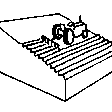
农艺措施
- A2:有机质/土壤肥力
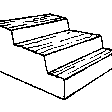
结构措施
- S2:堤、岸

管理措施
- M6:废物管理(回收、再利用或减少)
注释:
Residue management of trees is used for fuel, and alfalfa is utilized as livestock fodder in winter.
3.7 该技术强调的主要土地退化类型

土壤水蚀
- Wt:表土流失/地表侵蚀

土壤风蚀
- Et:表土流失

化学性土壤退化
- Cn:肥力下降和有机质含量下降(非侵蚀所致)
- Ca:酸化
- Cp:土壤污染
- Cs:盐化/碱化
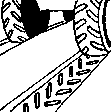
物理性土壤退化
- Pc:压实
- Pk:熟化和结壳
- Pw:水浸
- Ps:有机土壤沉降,土壤沉降
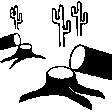
生物性退化
- Bc:植被覆盖的减少
- Bh:栖息地丧失
- Bq:数量/生物量减少
- Bs:质量和物种组成/多样性的下降
- Bl:土壤寿命损失
- Bp:害虫/疾病增加,捕食者减少

水质恶化
- Ha:干旱化
- Hg:地下水/含水层水位的变化
- Hp:地表水水质下降
- Hw:湿地缓冲能力下降
3.8 防止、减少或恢复土地退化
具体数量名该技术与土地退化有关的目标:
- 减少土地退化
- 修复/恢复严重退化的土地
注释:
This project reduced the land degradation by applying this agroforestry technology.
4. 技术规范、实施活动、投入和成本
4.1 该技术的技术图纸
技术规范(与技术图纸相关):
Saplings are planted in plotted areas with widths ranging from 4 to 5 meters. The outlines of the plots measure 40 × 50 meters, depending on the land structure. The spacing between saplings is 4 meters, with 5 meters between rows. Alfalfa and legume seeds are planted in the gaps. Small plots of 0.1 hectares were used, each containing 50 saplings.
作者:
Ahmad Zia Jalalzai
日期:
16/10/2024
4.2 有关投入和成本计算的一般信息
具体说明成本和投入是如何计算的:
- 每个技术区域
注明尺寸和面积单位:
0.1 ha
具体说明成本计算所用货币:
- 美元
注明雇用劳工的每日平均工资成本:
5 USD
4.3 技术建立活动
| 活动 | 时间(季度) | |
|---|---|---|
| 1. | Survey and site selection follow by feasibility study | December to January |
| 2. | Procurement sapling and equipment | December and January |
| 3. | Levelling plots, cleaning from weeds | March |
| 4. | Designing layout | March |
| 5. | Digging planting pits | March |
| 6. | Planating apple saplings | spring |
| 7. | Irrigating | April to September |
| 8. | Training and pruning of orchard | October and Noverber |
4.4 技术建立所需要的费用和投入
| 对投入进行具体说明 | 单位 | 数量 | 单位成本 | 每项投入的总成本 | 土地使用者承担的成本% | |
|---|---|---|---|---|---|---|
| 劳动力 | Labour for preparation of plots levelling, digging pits and cleaning weeds | Person/day | 10.0 | 5.0 | 50.0 | 100.0 |
| 劳动力 | Labour for plantation | Person/day | 5.0 | 8.0 | 40.0 | 100.0 |
| 设备 | Shovel | Number | 1.0 | 4.0 | 4.0 | 100.0 |
| 设备 | Rope | Meter | 1.0 | 2.0 | 2.0 | 100.0 |
| 设备 | Hoe | Number | 1.0 | 3.0 | 3.0 | 100.0 |
| 设备 | Pruning scissors | Number | 1.0 | 10.0 | 10.0 | 100.0 |
| 设备 | Wheelbarrow | Number | 1.0 | 1.0 | 1.0 | 100.0 |
| 植物材料 | Alfalfa seeds | Kg | 4.0 | 3.0 | 12.0 | |
| 植物材料 | Apple sapling | Number | 50.0 | 1.0 | 50.0 | |
| 肥料和杀菌剂 | DAP | Kg | 25.0 | 3.0 | 75.0 | |
| 肥料和杀菌剂 | Urea | Kg | 25.0 | 1.0 | 25.0 | |
| 技术建立所需总成本 | 272.0 | |||||
| 技术建立总成本,美元 | 272.0 | |||||
4.5 维护/经常性活动
| 活动 | 时间/频率 | |
|---|---|---|
| 1. | Applying manure for growth of crops and trees(refers to using organic animal waste (such as cow, horse, chicken, or sheep manure) to improve soil fertility and promote plant growth.) | in fall season |
| 2. | Disc ploughing and harrowing | in fall season |
| 3. | Chemical fertilizer application to crops | at the time of observing needs |
| 4. | Pest management with chemicals | in spring season |
| 5. | Irrigation of sapling | As per needed time |
| 6. | Mulching trees (humus cover)refers to the practice of covering the soil around trees with organic material, such as humus, straw, leaves, wood chips, or compost. | In a hot summer and lack of water, dry year |
| 7. | Pruning trees | in spring season |
| 8. | Operation and maintenance | spring, summer and fall |
注释:
Inputs needed for maintenance/ recurrent activities (per year)
4.6 维护/经常性活动所需要的费用和投入(每年)
| 对投入进行具体说明 | 单位 | 数量 | 单位成本 | 每项投入的总成本 | 土地使用者承担的成本% | |
|---|---|---|---|---|---|---|
| 劳动力 | Unskilled labour | Person/day | 20.0 | 5.0 | 100.0 | 100.0 |
| 劳动力 | ploughing | person/day | 2.0 | 5.0 | 10.0 | |
| 劳动力 | apply of fertilizer and manure | person/day | 2.0 | 5.0 | 10.0 | |
| 劳动力 | form pest management | person/day | 3.0 | 5.0 | 15.0 | |
| 劳动力 | planting of annual crops / perennial alfalfa | person/day | 2.0 | 5.0 | 10.0 | |
| 劳动力 | Uprooting dry sapling and replacing to fresh sapling. | Number | 2.0 | 1.0 | 2.0 | 100.0 |
| 设备 | Shovel | Number | 1.0 | 3.0 | 3.0 | 100.0 |
| 肥料和杀菌剂 | Organic fertilizer | M3 | 1.0 | 10.0 | 10.0 | 100.0 |
| 肥料和杀菌剂 | DAP | |||||
| 肥料和杀菌剂 | Urea | |||||
| 肥料和杀菌剂 | Pesticides | |||||
| 技术维护所需总成本 | 160.0 | |||||
| 技术维护总成本,美元 | 160.0 | |||||
注释:
After establishment, all responsibilities for maintenance, operations activity, care, and management belongs to land users.
4.7 影响成本的最重要因素
描述影响成本的最决定性因素:
Usually, the land users are farmers, and all the activities are performed by the land users. The project team provides technical support and capacity building. The most important factors affecting the cost in the project are the materials’ accessibility in the field such as saplings, chemical fertilizer, and pesticides.
5. 自然和人文环境
5.1 气候
年降雨量
- < 250毫米
- 251-500毫米
- 501-750毫米
- 751-1,000毫米
- 1,001-1,500毫米
- 1,501-2,000毫米
- 2,001-3,000毫米
- 3,001-4,000毫米
- > 4,000毫米
农业气候带
- 半干旱
5.2 地形
平均坡度:
- 水平(0-2%)
- 缓降(3-5%)
- 平缓(6-10%)
- 滚坡(11-15%)
- 崎岖(16-30%)
- 陡峭(31-60%)
- 非常陡峭(>60%)
地形:
- 高原/平原
- 山脊
- 山坡
- 山地斜坡
- 麓坡
- 谷底
垂直分布带:
- 0-100 m a.s.l.
- 101-500 m a.s.l.
- 501-1,000 m a.s.l.
- 1,001-1,500 m a.s.l.
- 1,501-2,000 m a.s.l.
- 2,001-2,500 m a.s.l.
- 2,501-3,000 m a.s.l.
- 3,001-4,000 m a.s.l.
- > 4,000 m a.s.l.
关于地形的注释和进一步规范:
As the technology have been applied in a 400 different topography plots, some of the plots are in a flatted, gentle and hilly slop and most of the technologies are applied in flatted area.
5.3 土壤
平均土层深度:
- 非常浅(0-20厘米)
- 浅(21-50厘米)
- 中等深度(51-80厘米)
- 深(81-120厘米)
- 非常深(> 120厘米)
土壤质地(表土):
- 中粒(壤土、粉土)
土壤质地(地表以下> 20厘米):
- 中粒(壤土、粉土)
表土有机质:
- 中(1-3%)
如有可能,附上完整的土壤描述或具体说明可用的信息,例如土壤类型、土壤酸碱度、阳离子交换能力、氮、盐度等。:
In Ghazni province, the primary soil types include Aridisols in arid regions, Entisols on slopes, Sierozems in desert areas, and fertile Alluvial soils in valleys that support agriculture. Soil pH levels in the region range from 6.33 (slightly acidic) to 8.52 (alkaline), indicating varying degrees of acidity and alkalinity. The Cation Exchange Capacity (CEC), nitrogen levels, and salinity vary across these soil types, influencing agricultural productivity and land management practices. For more detailed information, including specific nutrient content and soil characteristics, resources such as the FAO’s Agro-Climatic Atlas can be consulted.
5.4 水资源可用性和质量
地下水位表:
5-50米
地表水的可用性:
过量
水质(未处理):
良好饮用水
水质请参考::
地下水和地表水
水的盐度有问题吗?:
否
该区域正在发生洪水吗?:
是
规律性:
偶然
关于水质和水量的注释和进一步规范:
In years with heavy snowfall, water availability increases, and springs are replenished. Conversely, during drought years, water resources decrease significantly. From July to September, a water shortage is commonly experienced, prompting farmers to transport water from canals using animals. Additionally, some farmers rely on groundwater specifically for irrigating saplings. This seasonal variation in water supply is critical for agricultural practices in the province.
5.5 生物多样性
物种多样性:
- 中等
栖息地多样性:
- 中等
5.6 应用该技术的土地使用者的特征
定栖或游牧:
- 定栖的
生产系统的市场定位:
- 混合(生计/商业)
非农收入:
- 收入的10-50%
相对财富水平:
- 非常贫瘠
- 贫瘠
个人或集体:
- 个人/家庭
机械化水平:
- 手工作业
性别:
- 女人
- 男人
土地使用者的年龄:
- 中年人
- 老年人
5.7 应用该技术的土地使用者使用的平均土地面积
- < 0.5 公顷
- 0.5-1 公顷
- 1-2 公顷
- 2-5公顷
- 5-15公顷
- 15-50公顷
- 50-100公顷
- 100-500公顷
- 500-1,000公顷
- 1,000-10,000公顷
- > 10,000公顷
这被认为是小规模、中规模还是大规模的(参照当地实际情况)?:
- 中等规模的
注释:
Everyone individually has possessed land ranging from 0.5 hectares to 2 hectares in communities. However, land users has allocated only 0.1 hectares of land for the application of this technology.
5.8 土地所有权、土地使用权和水使用权
土地所有权:
- 社区/村庄
- 个人,有命名
土地使用权:
- 社区(有组织)
- 个人
用水权:
- 自由进入(无组织)
- 社区(有组织)
土地使用权是否基于传统的法律制度?:
是
具体说明:
The traditional system refers to a record that recognizes land ownership and is issued based on the customs and traditions of local communities. This document is not legal but is used within the community to validate ownership.
注释:
The land in this area is privately owned, while the rangeland is government-owned and accessible for public use. However, some individuals have encroached the rangeland, converting it into agricultural land and claiming it as their own property, despite lacking legal ownership documentation.
5.9 进入服务和基础设施的通道
健康:
- 贫瘠
- 适度的
- 好
教育:
- 贫瘠
- 适度的
- 好
技术援助:
- 贫瘠
- 适度的
- 好
就业(例如非农):
- 贫瘠
- 适度的
- 好
市场:
- 贫瘠
- 适度的
- 好
能源:
- 贫瘠
- 适度的
- 好
道路和交通:
- 贫瘠
- 适度的
- 好
饮用水和卫生设施:
- 贫瘠
- 适度的
- 好
金融服务:
- 贫瘠
- 适度的
- 好
6. 影响和结论性说明
6.1 该技术的现场影响
社会经济效应
生产
作物生产
SLM之前的数量:
0
SLM之后的数量:
Now we have 400 apple orchards
注释/具体说明:
In the past, there were no apple orchard in this area. The community mostly relied on the rangeland, and the animal feed was limited then. Due to the application of these technologies, the apple orchard has increased, and alfalfa intercrops have been expanded for animal feeding. As a result, pressure on the rangeland has decreased.
作物质量
SLM之前的数量:
less then 10 orchard. No alfaalf crops
SLM之后的数量:
400 orchards with Alfaalfa crops
注释/具体说明:
Alfalfa intercrops have become friendly feeds for animals, along with other grasses harvested from the rangeland.
饲料生产
SLM之前的数量:
less then 10 plots of Alfaalfa
SLM之后的数量:
400 plots
饲料质量
注释/具体说明:
Crops production specifically grown to feed livestock. It plays a crucial role in ensuring a steady supply of nutritious feed for animals, especially in dairy and meat production systems.
畜牧生产
水资源可用性和质量
家畜用水的可用性
家畜用水的质量
灌溉用水的可用性
收入和成本
农业收入
SLM之前的数量:
It is not distinguishable for now
SLM之后的数量:
It is not distinguishable for now
注释/具体说明:
The cultivation of apple orchards and alfalfa crops has significant environmental, economic, and agricultural benefits. When grown together in an agroforestry system, they create a sustainable and productive farming model.
其它社会经济效应
The cultivation of apple orchards and alfalfa crops has significant environmental, economic, and agricultural benefits. When grown together in an agroforestry system, they create a sustainable and productive farming model.
SLM之前的数量:
It is not distinguishable for now
SLM之后的数量:
It is not distinguishable for now
注释/具体说明:
The cultivation of apple orchards and alfalfa crops has significant social benefits, contributing to rural development, employment, food security, and community well-being.
社会文化影响
食品安全/自给自足
SLM之前的数量:
less then 10 orchard
SLM之后的数量:
400
注释/具体说明:
Food security is achieved when people have consistent access to sufficient, safe, and nutritious food to maintain a healthy life. The cultivation of apple orchards and alfalfa crops plays a crucial role in enhancing food security by ensuring the availability of fruits, livestock feed, and sustainable agricultural income.
健康状况
SLM之前的数量:
less then 10 orchard
SLM之后的数量:
400 orchard
注释/具体说明:
The cultivation of apple orchards and alfalfa crops has a direct and indirect impact on human and animal health. These crops provide essential nutrients, improve environmental conditions, and contribute to sustainable food systems that enhance overall well-being.
娱乐机会
SLM之前的数量:
less then 10 orchard
SLM之后的数量:
400
注释/具体说明:
The cultivation of apple orchards and alfalfa crops not only provides food and economic benefits but also creates various recreational opportunities. These activities promote tourism, community engagement, and overall well-being, contributing to rural development and environmental appreciation.
SLM/土地退化知识
注释/具体说明:
The cultivation of apple orchards and alfalfa crops plays a significant role in Sustainable Land Management (SLM) by improving soil health, preventing degradation, and enhancing ecosystem services. Properly managed apple orchards and alfalfa fields help restore land fertility, prevent erosion, and support long-term agricultural sustainability.
生态影响
土壤
土壤水分
注释/具体说明:
The cultivation of apple orchards and alfalfa crops has significant effects on soil moisture due to their respective water demands, root systems, and overall impact on the surrounding ecosystem. Both crops, when properly managed, can help retain moisture in the soil and improve its structure, but if mismanaged, they can also lead to issues like water depletion or soil erosion.
土壤覆盖层
注释/具体说明:
The cultivation of apple orchards and alfalfa crops can have significant effects on soil cover, which plays a crucial role in protecting the soil from erosion, enhancing water retention, and promoting overall soil health. Proper management of soil cover is essential for ensuring sustainable agricultural practices and maintaining soil fertility over time.
土壤有机物/地下C
注释/具体说明:
The cultivation of apple orchards and alfalfa crops plays a significant role in the accumulation and dynamics of soil organic matter (SOM) and below-ground carbon (C). Both of these components are essential for soil fertility, carbon sequestration, and overall ecosystem health. The management of these factors has critical implications for sustainable farming practices, climate change mitigation, and long-term soil productivity.
生物多样性:植被、动物
有益物种
减少气候和灾害风险
洪水影响
注释/具体说明:
Floods are one of the most significant climate-related risks that can affect agricultural systems, particularly in regions prone to heavy rainfall or where irrigation infrastructure is inadequate. Both apple orchards and alfalfa crops are vulnerable to flood impacts, which can result in loss of yield, soil degradation, and cause damage to the overall ecosystem. However, with effective disaster risk reduction strategies, the negative impacts of floods on these crops can be mitigated.
干旱影响
注释/具体说明:
apple orchards and alfalfa crops are highly sensitive to water stress, and prolonged drought conditions can reduce crop yields, degrade soil quality, and negatively affect the overall health of these plants. Understanding the impacts of drought on these crops and implementing appropriate water management strategies are crucial for maintaining agricultural productivity in drought-prone areas.
6.2 该技术的场外影响已经显现
水资源可用性
注释/具体说明:
The cultivation of apple orchards and alfalfa crops, especially when enhanced by technology, can have significant off-site impacts on water availability. These impacts stem from how irrigation systems, water management practices, and agricultural technologies influence local and regional water resources, hydrology, and ecosystems. Off-site effects include changes to water quality, water use efficiency, and the sustainability of water resources in surrounding areas.
6.3 技术对渐变气候以及与气候相关的极端情况/灾害的暴露和敏感性(土地使用者认为的极端情况/灾害)
注释:
The cultivation of apple orchards and alfalfa crops is highly sensitive to both gradual climate change and climate-related extremes like floods, droughts, and temperature fluctuations. These climate impacts affect not only the crops' growth and yield but also the technologies used in managing these crops. Understanding the exposure and sensitivity of these agricultural technologies to such climate factors is crucial for farmers and land users to ensure long-term sustainability.
6.4 成本效益分析
技术收益与技术建立成本相比如何(从土地使用者的角度看)?
短期回报:
中性/平衡
长期回报:
非常积极
技术收益与技术维护成本/经常性成本相比如何(从土地使用者的角度看)?
短期回报:
中性/平衡
长期回报:
积极
注释:
Before the project was implemented, the land was either used for wheat cultivation or left fallow. With the introduction of the agroforestry project, tree seedlings were planted, and alfalfa was grown. In some plots, legumes were cultivated instead of alfalfa. In the first year, the production of alfalfa and legumes significantly outpaced the wheat yield, resulting in high levels of satisfaction and happiness among the local communities.
6.5 技术采用
- 1-10%
在所有采用这项技术的人当中,有多少人是自发的,即未获得任何物质奖励/付款?:
- 11-50%
注释:
In addition to the 400 gardens established through the project, local communities independently created 50 small and large gardens without any financial assistance. They purchased saplings from the market and, having previously received capacity-building training from the project team, applied agroforestry practices on plots of various sizes, tailored to their available land.
6.6 适应
最近是否对该技术进行了修改以适应不断变化的条件?:
否
6.7 该技术的优点/长处/机会
| 土地使用者眼中的长处/优势/机会 |
|---|
| Integrated systems that combine apple trees with alfalfa and legumes offer several benefits. Farmers appreciated the enhanced biodiversity, which supports pest control and improves pollination, leading to healthier crops and increased yields. The intercropping of legumes is particularly valued for its role in improving soil fertility through nitrogen fixation, reducing dependence on synthetic fertilizers, and promoting sustainable farming practices. |
| Economically, farmers find that this system provides diversified income sources, as they can sell both fruit and forage crops, which mitigates risks associated with crop failure. Additionally, the ability to optimize land use while maintaining ecological balance is a significant advantage. This resource efficiency, coupled with the adaptability of practices to different climates and soils, enables farmers to achieve resilience against climate variability. |
| Furthermore, land users recognize the opportunities for community engagement and knowledge sharing to promotes agroforestry. As these systems gain popularity, farmers are increasingly accessing markets for sustainably produced goods, enhancing their profitability. With supportive policies of sustainable land management, the future of agroforestry initiatives appears promising, benefiting both the environment and local economies. |
| 编制者或其他关键资源人员认为的长处/优势/机会 |
|---|
| Integrated systems of apple trees intercropped with alfalfa and legumes are recognized for their multifaceted benefits. They highlight the importance of these systems in promoting sustainable agricultural practices, noting that the biodiversity fostered by agroforestry enhances pest control and supports healthier ecosystems. This ecological balance is crucial not only for soil health but also for mitigating the reliance on chemical inputs, which aligns with global sustainability goals (Nair, 2019; FAO, 2020). |
| Moreover, compilers emphasize the economic advantages of agroforestry. By diversifying income streams, these systems reduce financial risks for farmers and stabilize local economies. The adaptability of agroforestry practices to various climates and soil types allows for broader implementation, making it an attractive option for diverse agricultural settings (Schroth et al., 2004; Somarriba et al., 2016). |
| Key resource persons also note the social dimension of agroforestry, as these systems encourage community engagement and collaboration. This participatory technology fosters knowledge sharing, leading to improved agricultural practices and strengthening local capacities. With increasing support from policies advocating for sustainable land management, agroforestry initiatives are well-positioned for growth and development, contributing to both environmental health and economic resilience (Pretty, 2018; Wang et al., 2020). |
6.8 技术的弱点/缺点/风险及其克服方法
| 土地使用者认为的弱点/缺点/风险 | 如何克服它们? |
|---|---|
| Initial costs and investment risks | The project team provided seedlings, fertilizers, and Alfalfa seeds at the start of the technology. Land users were responsible for carrying out physical activities such as digging holes, planting seedlings, and irrigation, which helps reduce costs and fosters a sense of ownership among the participants. |
| Low knowledge of the technology and skill gaps | To address educational gaps, the project’s field team conducted capacity-building programs and workshops before implementing the technology. This initiative has enabled land users to become familiar with new methods and enhance their capabilities in agroforestry |
| Market access and economic viability | The project team established agroforestry committees and facilitated direct market communication and improved access for land users to sell their produce. It has provided sales skills training to land users, allowing them to make more profit from their produce |
| 4) Pest and disease management: | 4) The project's field team has educated land users about common pests and diseases in the area and provided them with preventive management strategies. In case of new issues, they have been linked with the Department of Agriculture to ensure timely and effective support. |
| 编制者或其他关键资源人员认为的弱点/缺点/风险 | 如何克服它们? |
|---|---|
| Provision of Resources and Local Engagement: | Importance of equipping land users with essential materials, such as sapling and fertilizers, to lower initial barriers and encourage participation. Enhance ownership to ensure sustainability when the project pulls out |
| Addressing educational gaps | Realizing that knowledge gaps could hinder the project’s success, the team implemented pre-launch training workshops. These sessions were aimed at familiarizing land users with innovative agroforestry, helping to ensure their understanding and effective implementation of new techniques. |
| Market connections and economic benefits | Key resource personnel highlighted the importance of establishing market access for sustainable success. By Rangeland management Association and offering training in market engagement, the project helped land users gain market literacy, empowering them to maximize income potential from their produce. |
| Support for pest and disease management | The project team prioritized proactive pest and disease management by training land users in common pest prevention techniques. The creation of a support network with the Department of Agriculture ensures that land users have access to timely guidance for any emerging issues, ensuring resilience and adaptability in their practices. |
7. 参考和链接
7.1 信息的方法/来源
- 实地考察、实地调查
Field visits and field surveys by project team
- 与土地使用者的访谈
About one per agroforestry plot by project team
- 与SLM专业人员/专家的访谈
Three people - project implementation unit.
- 根据报告和其他现有文档进行编译
Field reports and documents.
(现场)数据是什么时候汇编的?:
16/12/2024
链接和模块
全部展开 全部收起链接
无链接
模块
无模块


